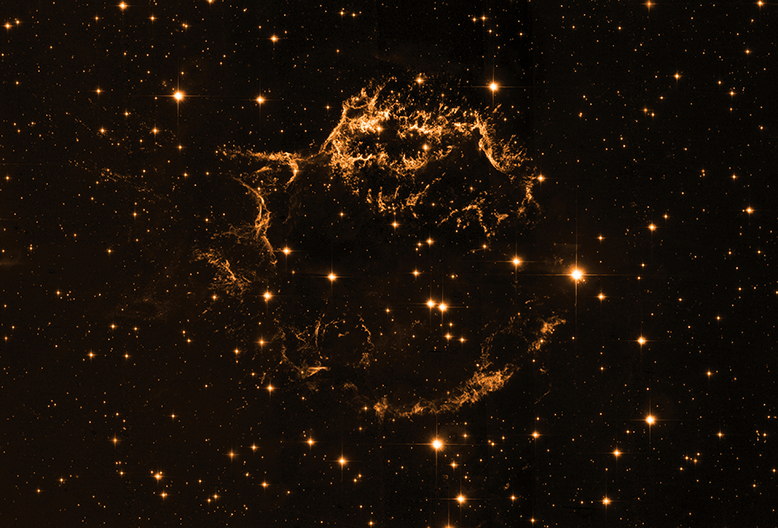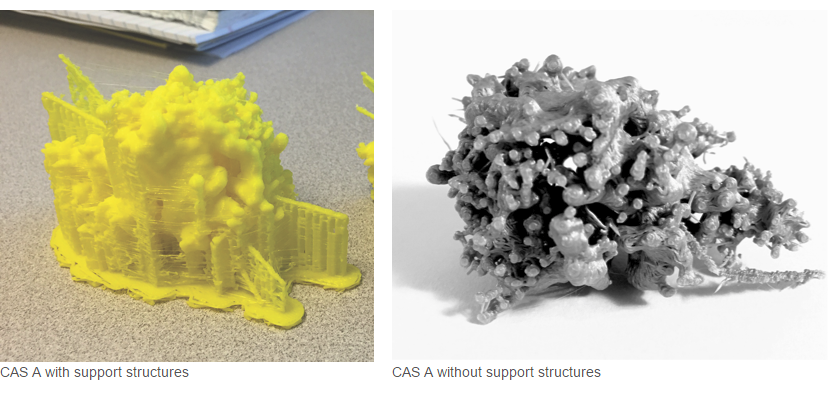
How to Hold a Dead Star in Your Hand
Objects in space are rather far away. The Moon is our closest celestial neighbor at nearly a quarter million miles from Earth, and the nearest star, our Sun, is 93 million miles away.
These extreme distances mean that it’s usually impossible to touch real objects in space (meteorites that fall to the ground not withstanding). Advances in both astronomy and technology, however, now allow you to do the next best thing: hold a 3-D model of one based on real data. Cassiopeia A is located about 10,000 light years from Earth. How does that compare with our local cosmic objects of the Sun and Moon? One light year equals the distance that light travels in a year, or just under 6 trillion miles (~10 trillion km). This means that Cassiopeia A is an impressive 60,000,000,000,000,000 miles (100,000,000,000,000,000 km) from Earth. But since it’s in our Milky Way, it’s in our cosmic back yard, so to speak.
The story behind such a remarkable feat starts with how astronomers study space. Unlike previous generations of sky gazers, today’s astronomers look at the Universe in many kinds of light, across the full electromagnetic spectrum. Through advanced telescopes and detectors, scientists can “see” from radio waves to gamma rays. Why is this important? We need to look at the Universe in all the types of lights to even begin to understand it. Take X-rays, for example. Back in 1999, NASA’s Chandra X-ray Observatory was launched in order to observe the high-energy Universe including such things as colliding galaxies, black holes, and supernova remnants.
Supernova Remnant Cassiopeia A
One such supernova remnant that Chandra studies is Cassiopeia A. About 400 years ago, in our own Milky Way galaxy, a star that was about 15 to 20 times the mass of our Sun, detonated in a supernova explosion. If we look at Cassiopeia A in optical light, the kind the human eye detects, we see delicate filamentary structure at around 10,000 degrees Celsius.
Death comes alive in the X-ray image of Cassiopeia A from Chandra, however, looking at material that’s millions of degrees hot. There is so much energy that it heats up the debris field to temperatures that cause the material to glow in X-ray light.

Cassiopeia A, Optical, Credit: NASA/STScI

Cassiopeia A, X-ray, Credit: NASA/CXC/SAO
Processing the Data
When a satellite such as Chandra observes an object in space, its camera records photons, a packet of energy that makes up electromagnetic radiation, a.k.a. light. The arrivals of these photons are recorded by detectors aboard Chandra and delivered to Earth via NASA’s Deep Space Network, a series of large radio dishes around the globe. The data are coded in the form of 1’s and 0’s, and scientific software (back on Earth) then translates that data into a table that contains the time, energy and position of each photon that struck the detector during the observation. The data are further processed with software to form the visual representation of the object.
Once the data are in the form of an image, different colors can be assigned to various slices of light detected. For example, a common color palette of chromatic ordering is based on the amount of energy and often includes three layers: red is applied to the lowest energy band, green to the medium, and then blue to the highest energy band in the dataset. When this is done for X-rays detected for Cassiopeia A, new and important information is revealed. The blue, wispy arcs in the image show where the acceleration is taking place in an expanding shock wave generated by the explosion. The red and green regions show material from the destroyed star that has been heated to millions of degrees by the explosion.

Credit: NASA/CXC/SAO
NASA’s Chandra X-ray Observatory has observed Cas A many times over the more than 25 years it has been in operation.The aggregate amount of observing time is well over over two million seconds, which means there is a great deal of information to work with. Scientists can use this rich dataset to go beyond a static image and see it moving over time.
Time Lapse Video, Credit: X-ray: NASA/CXC/SAO; Optical: NASA/STScI; Image Processing: NASA/CXC/SAO/J. Major, A. Jubett, K. Arcand
A time-lapse movie of Chandra’s X-ray data was made by combining 22 observations taken from 2000 through to 2019 Scientists can use this to measure the expansion velocity of the leading edge of the explosion’s outer blast wave. The researchers find that the velocity is about 11 million miles per hour. But that’s not all.
By combining X-rays from Chandra with infrared data from another orbiting NASA observatory, the Spitzer Space Telescope, plus visible light information from telescopes on the ground, something special can be done. For the first time, a three-dimensional reconstruction of a supernova remnant was created using these data taken in different types of light.
3-D Modelling
Because Cassiopeia A is the result of an explosion, the stellar debris is expanding radially outwards from the explosion center. Using simple geometry and the Doppler effect, we can create a 3-D model. That data were actually imported into a program originally used for brain imaging, which was then modified for astronomy data by the Astronomical Medicine Project at Harvard.
Scientific 3D model (Credit: NASA/CXC/MIT/T.Delaney et al.)
The insight into the structure of Cas A gained from this 3-D visualization is important for astronomers who build models of supernova explosions. Now, they must consider that the outer layers of the star come off spherically, but the inner layers come out more disk-like with high-velocity jets in multiple directions.
Visualization Fly Through (NASA/CXC/D.Berry)
While these 3-D models are exciting for astronomers who study exploded stars, the work on Cassiopeia A is not solely for experts. Collaboration with specialists at the Smithsonian Institution led to the creation of the first ever 3-D print of a supernova remnant based on observational data. And we have added two additional 3D printable models from even more recent examinations of this supernova remnant.
Cassiopeia A, 2023 Model (Credit: INAF-Osservatorio Astronomico di Palermo/Salvatore Orlando)
By modeling this supernova remnant with newer data and mathematical models, Orlando and his collaborators have shown that the massive clumps that developed soon after the star's explosion are likely responsible for the asymmetrical shape of Cas A. They calculated the kinetic energy (energy of motion) and masses of iron, silicon and sulfur involved in the explosion that could have been seen from Earth about 340 years ago.
Then, using NASA’s James Webb Space Telescope, astronomers uncovered a mysterious feature within the remnant, nicknamed the “Green Monster,” alongside a puzzling network of ejecta filaments forming a web of oxygen-rich material. When combined with X-rays from Chandra, the data helped astronomers shed light on the origin of the Green Monster and revealed new insights into the explosion that created Cas A about 340 years ago, from Earth’s perspective.
Cassiopeia A, "Green Monster" Model (Credit: INAF-Osservatorio Astronomico di Palermo/Salvatore Orlando)
In this model of Cassiopeia A, the 'Green Monster,' is revealed in 3D. The lumpy, ringed feature likely formed when clumps of debris from the explosion slammed into uneven material around the star, creating the pockmarked shape we see in the model.
That’s the story of how one cosmic object – or at least a representation of one – came down to Earth. It’s taken hundreds of years, a journey of trillions of miles, and some incredible scientific and technical advances, but now anyone can hold (the remains of) a dead star in their hand.
How to print your own supernova remnant
- Download the 3D files of Cassiopeia A Supernova remnant ( OBJ, STL)
- Download the 3D files of Cassiopeia A, 2023 model (OBJ, STL, GLB)
- Download the 3D files of Cassiopeia A, 2025 model (OBJ, STL, GLB)
- Read the brief instructions
-Select the 3D printer of your choice.
This example (shown left) was printed at 0.2mm layer height, 10% in-fill, 2 shells with MakerBot PLA filament at an extruder temperature of 215 C with a raft and supports. To make your 3D printed model more accurate, you will want to remove as much of the supporting material and raft as possible. Great care should be taken when performing this task to avoid breaking the jets. Most of the material will break off easily by hand, but you can get more accurate results enlisting the help of a few tools. If you have access to a heat gun, or hair drier, the plastic wisps left over from the supports can be removed by quickly applying a blast of heat. Be careful not to overheat, and melt the plastic. Additionally, you can use a Dremel or other similar rotary tool to sand away rough spots and carve out some of the interior gaps. As a final tip, you could use a soldering iron to weld some extra plastic to the base of the jets to reinforce them.

Disclaimer: The Chandra X-ray Center does not endorse any commercial product.
Watch the TEDX TALK
This presentation, recorded at TEDxProvidence in 2016, steps through the process of transformation and translation on how to take a supernova into the third dimension. Go behind the scenes on how to hold (the remains of) a dead star in your hands (in plastic, and in much smaller scale!) with Chandra's Visualization scientist, Dr. Kimberly Arcand.
RESOURCES
DOWNLOADABLES
How To Hold a Dead Star in Your Hand
3D Printing Handouts
Learn how to print your own 3D copies of the Chandra X-ray Observatory spacecraft
and the first-ever 3D print of an exploded star Cassiopeia A.
LINKS TO OTHER ACTIVITIES
Coding & Astronomy
Recoloring the Universe with Pencil Code
3D Printing
Universe in 3D
Astronomy
Make the Most of Your Universe
Learn more at chandra.si.edu/corps





